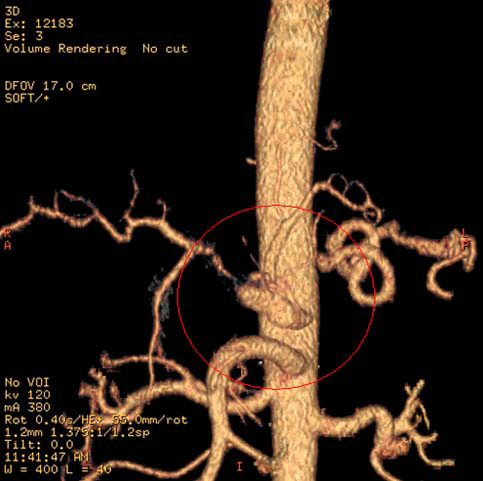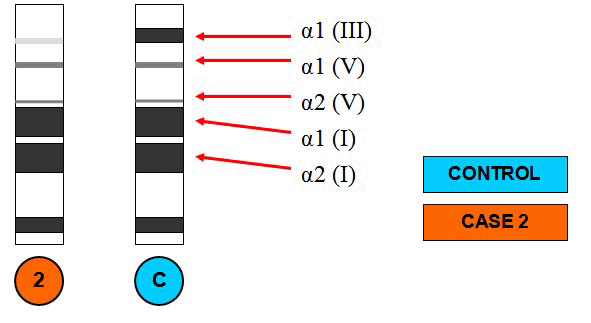
![]() Contributed by Rosemary Recavarren, MD, Mohamed Virji, MD, PhD, Lorna Cropcho and K. Michael Gibson, MD
Contributed by Rosemary Recavarren, MD, Mohamed Virji, MD, PhD, Lorna Cropcho and K. Michael Gibson, MD
CLINICAL HISTORY:
CASE 1
This 20-year-old-male patient presented to an outside institution with acute severe abdominal pain. A diagnosis of perforated viscus was made, followed by an emergency partial colectomy. The patient had poor recovery and was unstable during his post-surgical hospitalization with poor wound healing of the surgical area. A "second-look surgery" was performed due to intra-abdominal bleeding. This also revealed a segment of necrotic small bowel. The surgeon noted remarkable fragility and easy bleeding of the bowel tissue. After resection of the necrotic bowel, the patient's condition remained critical but stable. Approximately two weeks after this "second-look" surgery, the patient was transferred to our institution for a small bowel transplant with a diagnosis of short gut syndrome. The paramedics transporting the patient noticed a rapidly enlarging left forearm hematoma, which was evacuated after the patient was admitted to the intensive care unit.
The patient's condition deteriorated rapidly, with evidence of intra-abdominal bleeding. He was taken to the operating room. Soon after the start of the operation, the patient bled massively from both nostrils, requiring ENT surgeons to assist the anesthesiology team. The surgeons described the abdomen as having multiple perforations and the tissue being remarkably friable, representing a challenge to suture. Surgery was finished and the patient was transferred to the ICU. The 33 cm of bowel removed showed invasive candidiasis extending into the muscularis propria of the organ. The patient's condition continued to deteriorate. He developed sepsis and multiorgan failure. The patient was in the operating room 5 more times due to intra-abdominal bleeding, but as described by the surgeon, "all the intra-abdominal tissues were too friable to suture". His condition became critical and about three weeks after his admission the patient died.
Past Medical History:
The mother stated the patient had episodic abdominal pain for one year. During his childhood he suffered from nose bleedings and easy bruising. A few years ago he had a colectomy due to diverticulosis.
CASE 2
The patient, a 34-year-old white male with previous medical history of significant atrial fibrillation and a large "wrist aneurysm", presented to the hospital with vague abdominal discomfort. The family was concerned since there was a strong family history for sudden death due to abdominal aneurysms. He was evaluated with a CT scan that showed three splenic artery aneurysms (one 4 cm in size) with no evidence of rupture, as shown (circled) in the angiogram below:

Since the patient's condition was stable, the decision was to evaluate him with an angiogram with possible coil embolization. The patient was taken to the OR. Several attempts were made to pass the wire across the first aneurysm and into the more distal aneurysms, but eventually the procedure was aborted. The patient tolerated the procedure well and was taken to the recovery room in a stable condition. After this surgery, the patient underwent a CT scan, which demonstrated acute pulmonary emboli in the pulmonary arteries supplying the right upper lobe, right lower lobe as well as the left lower lobe. In the abdomen there was dissection of the celiac artery. The three splenic artery aneurysms were thrombosed, and there were two peripheral splenic infarctions with probable evolving right lobe hepatic infarct. A left common iliac artery aneurysm was also noted. A retroperitoneal hematoma surrounding the proximal celiac artery extending into the right perinephric space was observed. All these remained stable, and so also the hemoglobin and hematocrit. A hypercoagulation panel was negative. Given the large number of pulmonary emboli, which were an incidental finding, a decision was made to begin him on anticoagulation with heparin. Cardiology service recommended long-term anticoagulation with possible atrial sinus ablation in the future. He was also seen by the medical genetic service for evaluation of connective tissue disorders. A skin biopsy was performed to obtain tissue for skin fibroblast culture. The patient was discharged with specific guidance for management of his condition.
Laboratory Tests
Two exams were performed in both patients:
FIRST TEST:
Collagen Synthesis Cultured Skin Fibroblasts
Sodium Dodecyl sulphate-polyacrylamide gel electrophoresis (SDS-PAGE)
CASE 1: The skin biopsy showed microbial contamination and fibroblasts could not be cultured for the study.
CASE 2: Production of collagen type III was analyzed by metabolic labeling with 14C-proline followed by pepsin digestion and analysis on polyacrylamide gel electrophoresis, as shown below:

Sodium Dodecyl sulphate-polyacrylamide gel electrophoresis (SDS-PAGE) analysis of collagen produced by skin fibroblasts from patient on CASE 2 demonstrates alpha1 (III) band in the top of the gel. Compared to column C (control case) diminished collagen production is seen.
SECOND TEST:
Molecular Genetic Test - Sequencing of COL3A1 gene.
Both patients underwent sequencing analysis of COL3A1 gene.
CASE 1:
A mutation affecting mRNA splicing was detected:
Gene: COL3A1, Intron 27
Mutation site (UCSC-HGP): Chromosome 2 (189687622)
Mutation description: IVS27 + 1 G>C (in one allele)
Consequences on mRNA splicing: Exon 27 skipped (predicted)
Consequences on protein: Deletion of 18 amino acids in final protein
Using genomic DNA, exons 1 through 52 of the COL3A1 gene were amplified by reverse transcription-polymerase chain reaction (RT-PCR) and the products characterized by agarose gel electrophoresis. Subsequently, exon 27 and portions of the flanking intron sequences were PCR-amplified from genomic DNA and subsequently sequenced, thereby revealing the splice-site mutation IVS27+IG'C.